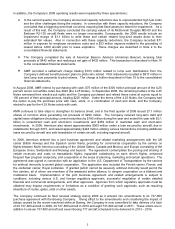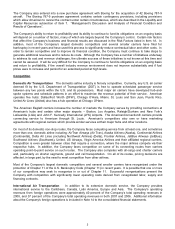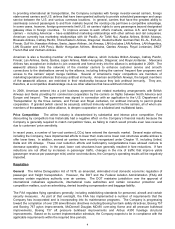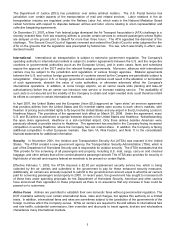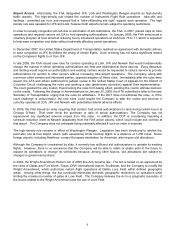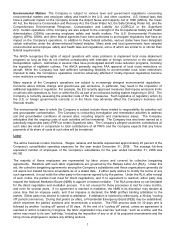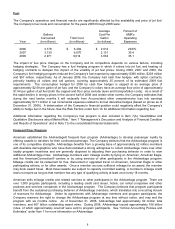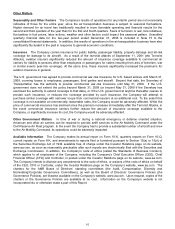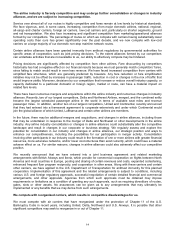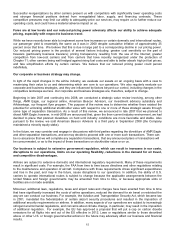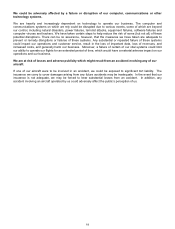American Airlines 2008 Annual Report Download - page 12
Download and view the complete annual report
Please find page 12 of the 2008 American Airlines annual report below. You can navigate through the pages in the report by either clicking on the pages listed below, or by using the keyword search tool below to find specific information within the annual report.
9
Fuel
The Company’s operations and financial results are significantly affected by the availability and price of jet fuel.
The Company's fuel costs and consumption for the years 2006 through 2008 were:
Year
Gallons
Consumed
(in millions)
Total Cost
(in millions)
Average
Cost Per
Gallon
(in dollars)
Percent of
AMR's
Operating
Expenses
2006
3,178
$ 6,402
$ 2.014
29.8%
2007
3,130
6,670
2.131
30.4
2008
2,971
9,014
3.034
35.1
The impact of fuel price changes on the Company and its competitors depends on various factors, including
hedging strategies. The Company has a fuel hedging program in which it enters into jet fuel and heating oil
hedging contracts to dampen the impact of the volatility of jet fuel prices. During 2008, 2007 and 2006, the
Company’s fuel hedging program reduced the Company’s fuel expense by approximately $380 million, $239 million
and $97 million, respectively. As of January 2009, the Company had cash flow hedges, with option contracts,
primarily heating oil collars and call options, covering approximately 35 percent of its estimated 2009 fuel
requirements. The consumption hedged for 2009 by cash flow hedges is capped at an average price of
approximately $2.59 per gallon of jet fuel, and the Company’s collars have an average floor price of approximately
$1.94 per gallon of jet fuel (both the capped and floor price exclude taxes and transportation costs). As a result of
the rapid decline in energy prices in the second half of 2008 and certain other events, the Company estimates that
during the next twelve months it will reclassify from Accumulated other comprehensive loss into earnings
approximately $711 million in net incremental expenses related to its fuel derivative hedges (based on prices as of
December 31, 2008). A deterioration of the Company’s financial position could negatively affect the Company’s
ability to hedge fuel in the future. See the Risk Factors under Item 1A for additional information regarding fuel.
Additional information regarding the Company’s fuel program is also included in Item 7(A) “Quantitative and
Qualitative Disclosures about Market Risk,” Item 7 “Management’s Discussion and Analysis of Financial Condition
and Results of Operations” and in Note 7 to the consolidated financial statements.
Frequent Flyer Program
American established the AAdvantage® frequent flyer program (AAdvantage) to develop passenger loyalty by
offering awards to travelers for their continued patronage. The Company believes that the AAdvantage program is
one of its competitive strengths. AAdvantage benefits from a growing base of approximately 62 million members
with desirable demographics who have demonstrated a strong willingness to collect AAdvantage miles over other
loyalty program incentives and are generally disposed to adjusting their purchasing behavior in order to earn
additional AAdvantage miles. AAdvantage members earn mileage credits by flying on American, American Eagle,
and the AmericanConnection® carriers or by using services of other participants in the AAdvantage program.
Mileage credits can be redeemed for free, discounted or upgraded travel on American, American Eagle or other
participating airlines, or for other awards. Once a member accrues sufficient mileage for an award, the member
may book award travel. Most travel awards are subject to capacity controlled seating. A member’s mileage credit
does not expire as long as that member has any type of qualifying activity at least once every 18 months.
American sells mileage credits and related services to other participants in the AAdvantage program. There are
over 1,000 program participants, including a leading credit card issuer, hotels, car rental companies and other
products and services companies in the AAdvantage program. The Company believes that program participants
benefit from the sustained purchasing behavior of AAdvantage members, which translates into a recurring stream
of revenues for AAdvantage. Under its agreements with AAdvantage members and program participants, the
Company reserves the right to change the AAdvantage program at any time without notice, and may end the
program with six months notice. As of December 31, 2008, AAdvantage had approximately 62 million total
members, and 607 billion outstanding award miles. During 2008, AAdvantage issued approximately 196 billion
miles, of which approximately one-half were sold to program participants. See “Critical Accounting Policies and
Estimates” under Item 7 for more information on AAdvantage.





